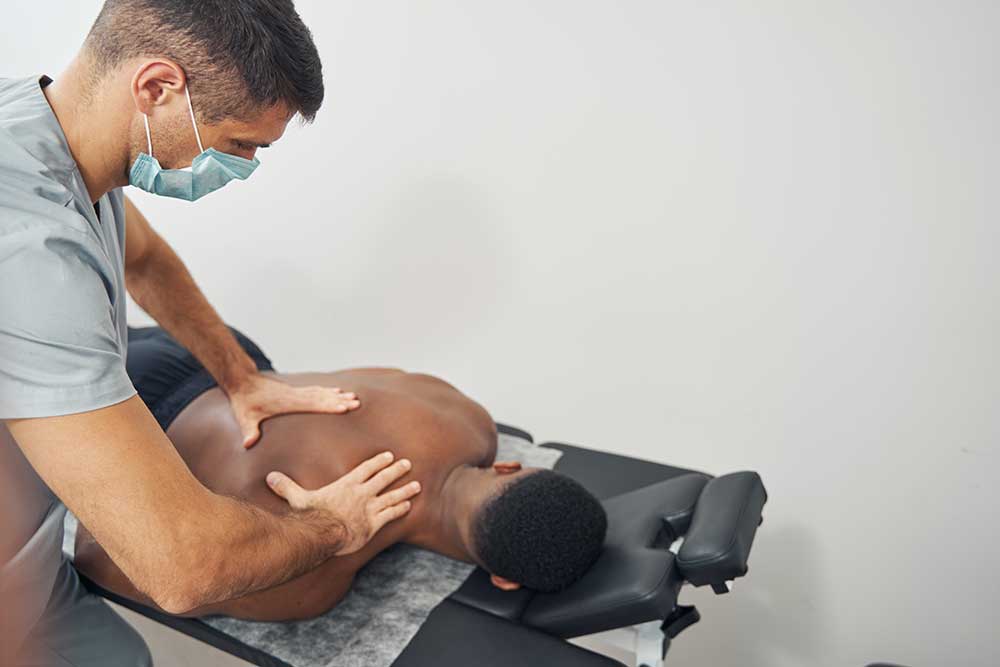Why Opt for Chiropractic Adjustments for Neck Alignment?
If you’re seeking ways to maintain proper neck alignment, you’re not alone. Many people grapple with neck-related issues, searching tirelessly for effective solutions. Among the myriad of options, chiropractic adjustments have emerged as a compelling choice. Known for their ability to directly tackle neck alignment issues, these adjustments have garnered considerable attention. But what makes them stand out?
As an authority in the field, I’ve witnessed firsthand the transformative power of chiropractic care. By leveraging my extensive experience, I aim to shed light on how chiropractic adjustments can significantly improve neck alignment. Through this exploration, you’ll gain insights into why chiropractic adjustments have become a popular method for managing neck alignment issues, and what you might expect from such treatment.
Key Takeaways
- Chiropractic adjustments for neck alignment provide immediate relief from soreness and pain.
- These adjustments can restore proper spinal alignment and improve nerve function.
- Chiropractic techniques reduce muscle spasms, relieve pressure, and improve neck mobility.
- Chiropractic adjustments are safe and effective, with minimal risks when performed by qualified professionals.
Benefits of Chiropractic Neck Adjustments
What are the benefits of chiropractic neck adjustments and how can they improve overall health and well-being?
Chiropractic neck adjustments have been shown to provide immediate relief for some patients by restoring spinal alignment. Misalignment of the neck can lead to a host of problems, including headaches, neck pain, and restricted movement. By realigning the vertebrae in the neck, chiropractic adjustments can help alleviate these issues and improve overall health and well-being.
One of the main benefits of chiropractic neck adjustments is the restoration of spinal alignment. When the neck is misaligned, it can put pressure on the nerves and cause pain and discomfort. By gently manipulating the neck, chiropractors can restore proper alignment and relieve this pressure, resulting in reduced pain and improved mobility.
In addition to pain relief, chiropractic neck adjustments can also have a positive impact on overall health. Research has shown that spinal manipulation can help boost the immune system and improve the body’s ability to heal itself. By restoring proper nerve function and removing interference in the nervous system, chiropractic adjustments can enhance the body’s natural healing abilities.
It is important to note that chiropractic neck adjustments are generally safe and have minimal risks associated with them. However, it is essential to seek care from a qualified and licensed chiropractor to ensure the best possible outcomes.
How Chiropractic Adjustments Improve Neck Alignment
Chiropractic adjustments play a crucial role in improving neck alignment by addressing misalignments and restoring proper spinal alignment. Neck adjustments are a common technique used by chiropractors to alleviate neck pain and improve overall neck function. Here’s how chiropractic adjustments can improve neck alignment:
-
Muscle Spasm Reduction: Chiropractic adjustments can help reduce muscle spasms in the neck, which are often a result of misalignments. By applying gentle pressure and realigning the vertebrae, chiropractors can relieve muscle tension and promote relaxation.
-
Pressure Relief: Misalignments in the neck can cause pressure on the nerves, leading to pain and discomfort. Through chiropractic adjustments, this pressure can be relieved, allowing for improved circulation and reduced inflammation in the neck area.
-
Restoring Neck Mobility: Misalignments can restrict movement and cause stiffness in the neck. Chiropractic adjustments can restore proper alignment, improving neck mobility and flexibility. This can allow individuals to move their neck more freely and without pain.
The Role of Chiropractic Techniques in Neck Alignment
Chiropractic techniques play a crucial role in achieving and maintaining proper neck alignment.
These techniques involve targeted adjustments that can help restore the natural curvature of the spine, alleviate muscle tension, and improve overall biomechanics.
Through specific manual manipulations, chiropractors can address misalignments, reduce nerve impingement, and promote optimal neck function, leading to enhanced mobility, reduced pain, and improved quality of life for patients.
Importance of Alignment
The proper alignment of the neck plays a crucial role in maintaining overall spinal health and preventing a range of associated issues. Chiropractic adjustments are a highly effective method for achieving and maintaining proper alignment of the neck.
Here are three key reasons why alignment is important:
-
Relief from neck pain and headaches: Misalignment of the neck can cause tension, stiffness, and pain, leading to chronic headaches and discomfort. Chiropractic adjustments restore alignment, relieving pain and reducing the frequency and intensity of headaches.
-
Improved mobility and reduced muscle spasms: Misalignment in the neck can restrict movement and lead to muscle spasms. Chiropractic neck adjustments restore mobility, alleviate muscle tension, and improve flexibility, allowing for a greater range of motion.
-
Prevention of long-term complications: When the neck is misaligned, it can put pressure on the surrounding nerves, leading to long-term complications if left untreated. Regular chiropractic adjustments help maintain proper alignment, reducing the risk of nerve compression and associated health issues.
Benefits of Chiropractic
Proper alignment of the neck is not only essential for relieving pain and preventing long-term complications, but it also serves as a foundation for the numerous benefits that chiropractic techniques offer in improving overall health and well-being.
Chiropractic adjustments specifically target the neck alignment, aiming to restore spinal alignment and alleviate problems caused by misalignment. One of the immediate benefits of chiropractic adjustments is the relief experienced by some patients. By realigning the neck, chiropractic techniques can help reduce pain and discomfort.
Furthermore, correcting neck alignment can have a positive impact on other areas of health. Misalignment in the neck can lead to issues such as headaches, migraines, and even digestive problems. Chiropractic adjustments can help alleviate these problems by addressing the root cause.
Importantly, chiropractic services come with minimal risks, making them a safe and effective option for improving overall health and well-being.
Techniques for Neck Adjustment
Neck adjustment techniques play a crucial role in restoring proper alignment and function of the neck, addressing issues such as muscle spasms and relieving pressure and tension. Chiropractic treatments for the neck, also known as cervical spine adjustments, offer a range of techniques to achieve these goals.
Here are three commonly used techniques:
-
Diversified Technique: This hands-on approach involves the chiropractor applying a quick, controlled thrust to specific areas of the neck to realign the joints and restore mobility.
-
Gonstead Technique: This technique focuses on identifying misalignments through X-rays and using precise adjustments to target the affected areas of the neck.
-
Activator Method: This technique utilizes a handheld instrument called an activator to deliver gentle and precise adjustments to the neck without manual manipulation.
Key Reasons to Choose Chiropractic Adjustments for Neck Alignment
Choosing chiropractic adjustments for neck alignment offers numerous benefits. Firstly, these adjustments provide a range of benefits, including immediate relief for some patients and the restoration of spinal alignment to alleviate problems caused by misalignment.
Additionally, chiropractic adjustments for neck alignment can improve overall health and well-being by restoring neck mobility, reducing muscle spasms, and relieving pressure and tension in the neck.
With their non-invasive nature and minimal risks, chiropractic adjustments are a trusted option for those seeking expert care for their spinal health.
Benefits of Adjustments
Chiropractic adjustments offer immediate relief and restore spinal alignment, providing a host of benefits for those seeking to improve their neck alignment and overall health. Here are some key benefits of chiropractic adjustments:
-
Alleviates a range of problems: Misalignment in the neck can cause various issues such as headaches, neck pain, and stiffness. Chiropractic adjustments can help alleviate these problems by realigning the spine and reducing pressure on the nerves.
-
Improves overall health: When the spine is properly aligned, it allows for optimal nerve function, which is crucial for overall health and well-being. Chiropractic care can improve the body’s ability to heal itself and enhance the immune system.
-
Minimal risks: Compared to other treatment options, chiropractic adjustments have minimal risks. They are non-invasive and drug-free, making them a safe and natural approach to neck alignment.
Non-Invasive Neck Alignment
With its ability to alleviate a range of problems associated with misalignment in the neck, chiropractic adjustments offer a safe and effective solution for those seeking non-invasive neck alignment. Chiropractors use their hands or specialized tools to apply controlled force to the spine, helping to restore proper alignment and mobility in the neck. This can relieve pressure and tension, improve flexibility, and promote overall well-being. Unlike invasive procedures or surgeries, chiropractic adjustments are considered non-invasive therapies, meaning they do not require incisions or anesthesia. Many patients find immediate relief after a chiropractic adjustment, and regular chiropractic care can provide long-term benefits such as improved athletic performance, increased blood flow to the brain, and relief from allergy symptoms and digestive issues.
| Benefits of Chiropractic Adjustments for Neck Alignment |
|---|
| – Alleviates problems associated with neck misalignment |
| – Restores neck mobility and relieves pressure and tension |
| – Safe and non-invasive procedure |
| – Improves flexibility, athletic performance, and blood flow to the brain |
| – Provides relief from allergy symptoms and improves digestion |
Expertise in Spinal Care
One of the key reasons to consider chiropractic adjustments for neck alignment is the expertise in spinal care that chiropractors possess. Chiropractors undergo years of specialized training and education to develop a deep understanding of the spine and its intricate workings. Their expertise allows them to effectively assess and diagnose misalignments in the neck and provide targeted adjustments to restore proper alignment.
Here are three ways chiropractors demonstrate their expertise in spinal care:
-
Chiropractors have an in-depth knowledge of the musculoskeletal system, enabling them to identify the underlying causes of neck misalignment and develop personalized treatment plans.
-
They use specific techniques and adjustments to gently manipulate the vertebrae in the neck, reducing muscle spasms, relieving pressure, and improving overall neck function.
-
Chiropractors prioritize patient safety and employ safe, non-invasive methods for neck adjustments, ensuring minimal associated risks.
What to Expect During Chiropractic Neck Adjustments
During chiropractic neck adjustments, it is crucial to maintain a state of complete relaxation. This allows the chiropractor to perform the adjustment more effectively and helps to minimize any discomfort or tension during the process. When you visit a chiropractor for a neck adjustment, here is what you can expect:
| Expectations | Explanation |
|---|---|
| Cracking or popping sounds | You may hear cracking or popping sounds during the adjustment. These sounds are normal and are caused by the release of gas bubbles in the joints as they are realigned. Although it may sound alarming, it is not painful and is simply the result of the adjustment. |
| Immediate relief from soreness and pain | One of the immediate benefits of chiropractic neck adjustments is relief from soreness and pain. By realigning the joints in the neck, pressure on nerves and muscles is reduced, providing relief from discomfort and allowing for improved mobility. |
| Comprehensive treatment plan | Chiropractic neck adjustments are often just one component of a comprehensive treatment plan. Depending on your specific condition, your chiropractor may recommend additional therapies such as stretching exercises, massage, or heat therapy to further support your neck health. |
| Restoration of neck mobility | Neck adjustments can help to restore neck mobility by addressing restrictions and imbalances in the joints. This can result in improved range of motion and increased flexibility in the neck. |
| Reduction of muscle spasms | Muscle spasms in the neck can be painful and restrict movement. Chiropractic neck adjustments can help to reduce muscle spasms by realigning the joints and relieving tension and pressure on the surrounding muscles. |
| Relief from pressure and tension in the neck | Pressure and tension in the neck can cause discomfort and even lead to headaches. Chiropractic neck adjustments can help to relieve this pressure and tension by realigning the joints and promoting better circulation and nerve function. |
Chiropractic neck adjustments offer a non-invasive and drug-free treatment option for individuals experiencing neck pain, stiffness, or reduced mobility. By understanding what to expect during these adjustments, you can approach your treatment with confidence and better support your overall neck health.
Safety and Effectiveness of Chiropractic Adjustments for Neck Alignment
Chiropractic adjustments for neck alignment have been shown to be safe and effective in providing immediate relief and restoring spinal alignment. When it comes to neck alignment, chiropractic adjustments offer several benefits:
-
Immediate relief: Chiropractic adjustments can provide immediate relief to patients suffering from neck pain and discomfort. The targeted manipulation of the spine helps alleviate problems caused by misalignments, reducing pain and improving mobility.
-
Restores spinal alignment: Chiropractors use specific techniques to realign the vertebrae in the neck, restoring proper spinal alignment. This can help alleviate tension, improve nerve function, and promote overall health and well-being.
-
Minimal risks: Chiropractic services for neck alignment are generally safe and carry minimal risks. Chiropractors undergo extensive training and are skilled in performing these adjustments safely. However, it is essential to consult with a qualified chiropractor and disclose any pre-existing conditions or concerns before undergoing treatment.



